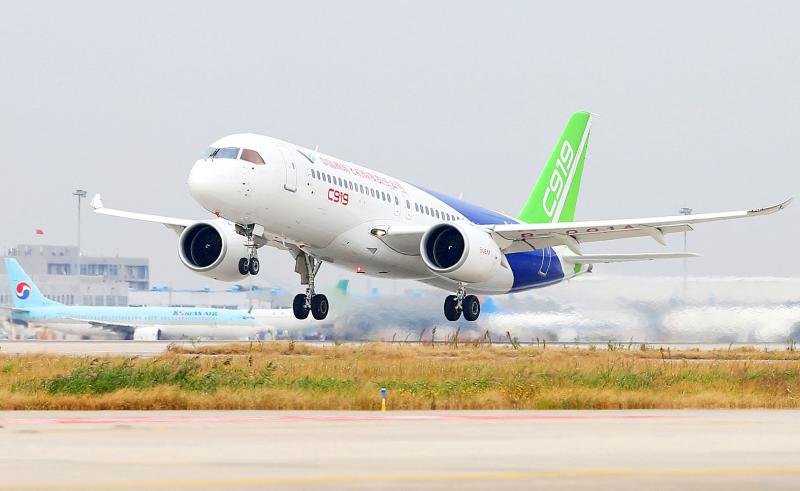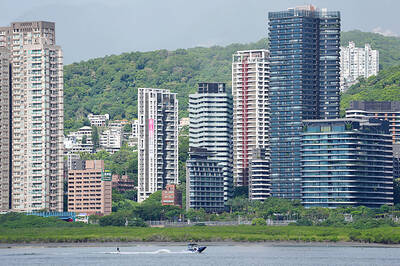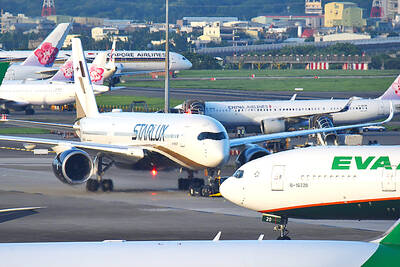China’s C919 jetliner — a no-show at the country’s biggest air show this week — has found it harder to meet certification and production targets amid tough US export rules, according to three people with knowledge of the program.
The state-owned manufacturer, Commercial Aircraft Corp of China (COMAC, 中國商用飛機), has been unable to get timely help from suppliers and has run out of some spare parts, the sources said.
As of December last year, the US has required special licenses to export parts and technology assistance to any company with ties to the Chinese military. That has hindered the C919 program, which has been in development for 13 years — one of the longest such periods in aviation.

Photo: AFP
The C919 is assembled in China, but relies heavily on Western components, including engines and avionics. That has made it vulnerable to crackdowns on key technology transfers.
US-linked suppliers are gradually receiving the licenses, but the setback has slowed down Chinese certification, and months-long delays threaten to affect early production, the sources said.
COMAC has 815 provisional orders, but only China Eastern Airlines Corp (中國東方航空) placed a firm order for five jets.
The state-backed airline said last month that it expects to receive its first C919 by the end of the year, two for next year and two more in 2023.
A slow production start would mean the C919 does not pose a near-term threat to Airbus SE and Boeing Co, which produce dozens of narrow-bodied aircraft a month.
“One of the biggest hurdles is going to be the supply chain, especially now with inflation, material availability and supplier changes,” said Alex Krutz, an aerospace supply chain expert at US-based aerospace consultancy Patriot Industrial Partners.
“The suppliers may not have the liquidity to make the post-certification changes or be willing as they were a few years ago to continue supporting an initial lower-rate production program like COMAC,” he added.
COMAC is years behind its initial certification schedule — one reason it did not take the C919 to the China Airshow.
“COMAC are very preoccupied with test flights. They’re behind schedule and are flying as much as they can to reach the minimum hours needed for Chinese certification,” an industry source said. “Despite all the issues, COMAC is very determined to get certified, as this is a paramount political task.”
Sources say that the C919 is likely to receive its type certificate from China’s aviation regulator by the end of this year, but that there will be a long list of limits on flight operations. Even after the certification, COMAC must make upgrades, the sources said.
The sources with knowledge of the C919 program said the jet’s progress seemed to mirror the certification pattern and slow production of its predecessor, the ARJ21 regional jet.
The ARJ21 faced a 30-month gap between obtaining a “type certificate,” which declares the design safe, and a “production certificate” allowing it to enter mass production.
That contrasts with the West, where those certificates are often granted almost simultaneously.
About 60 ARJ21 aircraft have been delivered to date, but the production ramp-up was also slow, rising from two planes a year in 2017 to 24 last year, according to COMAC data.

RECYCLE: Taiwan would aid manufacturers in refining rare earths from discarded appliances, which would fit the nation’s circular economy goals, minister Kung said Taiwan would work with the US and Japan on a proposed cooperation initiative in response to Beijing’s newly announced rare earth export curbs, Minister of Economic Affairs Kung Ming-hsin (龔明鑫) said yesterday. China last week announced new restrictions requiring companies to obtain export licenses if their products contain more than 0.1 percent of Chinese-origin rare earths by value. US Secretary of the Treasury Scott Bessent on Wednesday responded by saying that Beijing was “unreliable” in its rare earths exports, adding that the US would “neither be commanded, nor controlled” by China, several media outlets reported. Japanese Minister of Finance Katsunobu Kato yesterday also

Taiwan’s rapidly aging population is fueling a sharp increase in homes occupied solely by elderly people, a trend that is reshaping the nation’s housing market and social fabric, real-estate brokers said yesterday. About 850,000 residences were occupied by elderly people in the first quarter, including 655,000 that housed only one resident, the Ministry of the Interior said. The figures have nearly doubled from a decade earlier, Great Home Realty Co (大家房屋) said, as people aged 65 and older now make up 20.8 percent of the population. “The so-called silver tsunami represents more than just a demographic shift — it could fundamentally redefine the

China Airlines Ltd (CAL, 中華航空) said it expects peak season effects in the fourth quarter to continue to boost demand for passenger flights and cargo services, after reporting its second-highest-ever September sales on Monday. The carrier said it posted NT$15.88 billion (US$517 million) in consolidated sales last month, trailing only September last year’s NT$16.01 billion. Last month, CAL generated NT$8.77 billion from its passenger flights and NT$5.37 billion from cargo services, it said. In the first nine months of this year, the carrier posted NT$154.93 billion in cumulative sales, up 2.62 percent from a year earlier, marking the second-highest level for the January-September

‘DRAMATIC AND POSITIVE’: AI growth would be better than it previously forecast and would stay robust even if the Chinese market became inaccessible for customers, it said Taiwan Semiconductor Manufacturing Co (TSMC, 台積電) yesterday raised its full-year revenue growth outlook after posting record profit for last quarter, despite growing market concern about an artificial intelligence (AI) bubble. The company said it expects revenue to expand about 35 percent year-on-year, driven mainly by faster-than-expected demand for leading-edge chips for AI applications. The world’s biggest contract chipmaker in July projected that revenue this year would expand about 30 percent in US dollar terms. The company also slightly hiked its capital expenditure for this year to US$40 billion to US$42 billion, compared with US$38 billion to US$42 billion it set previously. “AI demand actually